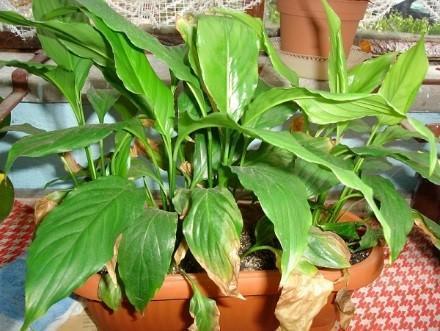Common problems when growing spathiphyllum and their solution
 Usually spathiphyllum grows in a lush, densely leafy bush. The leaves of a healthy plant are brightly colored, with a pleasant shine, without spots or damage, and look straight up.
Usually spathiphyllum grows in a lush, densely leafy bush. The leaves of a healthy plant are brightly colored, with a pleasant shine, without spots or damage, and look straight up.
If suddenly the condition of the leaf plates began to deteriorate, you should immediately pay attention to the flower, because the leaves serve as an indicator of its health. Withering or discoloration of the leaves indicates problems that have arisen, such as diseases or care errors. If you do not take timely measures to save the plant, in some, especially difficult cases, you can completely lose "female happiness".
How to do this depends on what caused the deterioration of the general condition spathiphyllum... Sometimes it is enough to simply adjust the care measures, and sometimes the use of special drugs is required. So let's figure it out.
Wilting leaves
The reason that the leaves of the spathiphyllum go down and droop can be:
- Insufficient or irregular watering... If the earthen lump is completely dry, you must immediately put the flowerpot in a container of water. Let it stand for half an hour so that the soil is saturated with moisture through the drainage holes. At the same time, you need to pour water directly into the pot. After that, it is imperative to drain the excess and pour out the water from the pan. In the future, water spathiphyllum when the top layer of the earth dries out (but not the whole coma!).
- Old soil... Over time, the plant takes all the nutrients from the soil. In addition, the overgrown root system completely fills the dishes. A dense earthen lump entwined with roots does not absorb water well. It is necessary to change the substrate and, if necessary, transplant the spathiphyllum into a more spacious pot, having washed the roots first.
Black spots appear on sluggish leaves
If spathiphyllum, growing in fresh soil, not only grafted, but black spots appeared on the leaves, there is already an overflow on the face.
The increased soil moisture leads to the development of putrefactive processes in the root system.
In this case, one cannot do without an urgent plant transplant with the removal of damaged roots and their further disinfection in a solution of potassium permanganate. Places of cuts should be sprinkled with charcoal or activated carbon.
2 days after transplantation, pour the spathiphyllum with a solution based on foundationol.
Drying leaves
Depending on how the leaves dry, the reasons can be completely opposite:
- tips dry out — too dry indoor air. To avoid this phenomenon, the flower should be regularly sprayed.
- half of the leaf dries out - too frequent watering. You need to take a break so that the earth dries up.
Yellowing of leaves
Most often, spathiphyllum turns yellow from excess sun. There may even be burns from direct rays, so it is better to keep the pot on the southeast window, and in the summer, the northern one will do. By the way, the leaves can turn yellow for a natural reason, if they are already old, but this is not a mass phenomenon.
In addition, yellowing of the leaves may mean that the flower is sick with chlorosis. It causes a lack of trace elements and irregular feeding.
To prevent the disease, the flower can be watered once a month with water with the addition of citric acid.
To restore the green color, it is better to change the soil, and feed the plant itself with a complex fertilizer, for example, Mr. Color.